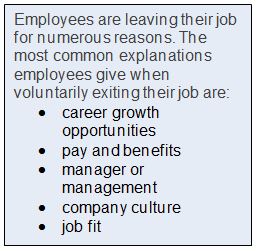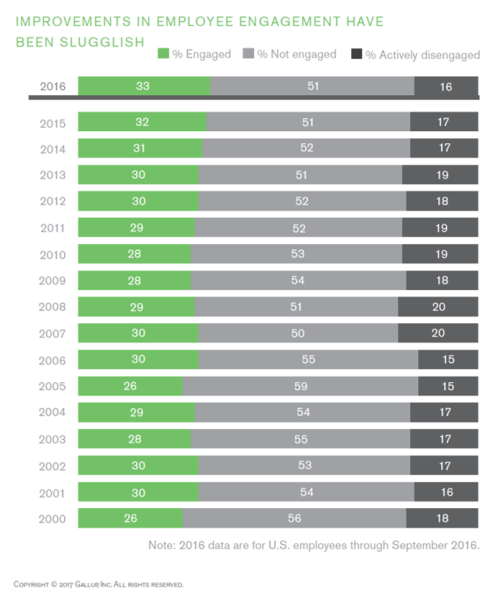Last month I wrote about the new Gallup report, State of the American Workplace, and discussed some of its broader findings. This week, I’m digging in a little more specifically.
Two of the chapters, “U.S. Workers: Increasingly Confident and Ready to Leave,” and “The Competitive Advantage of Engaging Employees,” should be required reading for all leaders as well as HR folks.
Let’s look at the chapter on U.S. workers having one foot out the door first. According to Gallup, “51% of U.S. employees say they are actively looking for a new job or watching for openings.” Think about that for a minute. A little more than half of your employees have at least one foot out the door.
Optimism about the job market is up for good reason — hiring is up. Gallup measures job creation and reports its Job Creation Index. In 2012 the Gallup Job Creation Index averaged +18. For the first three quarters of 2016, it averaged +32. So our employ ees have a deservedly high level of confidence that when they leave, they can find a good replacement job fairly quickly. It’s no wonder that many of our employees have a “grass is greener” outlook.
ees have a deservedly high level of confidence that when they leave, they can find a good replacement job fairly quickly. It’s no wonder that many of our employees have a “grass is greener” outlook.
And, of course, all of these reasons tie into your HR strategies, policies and plans. Your approach to employee engagement should be tying in to these 5 reasons for employee resignations.
While there are many definitions for employee engagement, this really caught my eye in the report:
Some leaders and managers believe the ultimate goal of employee engagement is higher levels of worker happiness and satisfaction. Happier workers certainly benefit an organization, but the real goal of employee engagement is improved business outcomes.
Boom! Let me quote this again: “…the real goal of employee engagement is improved business outcomes.” Every definition of employee engagement works here – as long as we understand the real outcome for which we’re working.
If employees are happier, they’ll work smarter and harder and quality will go up, improving our business outcomes.
If employees feel respected, they’ll be more committed and stay longer, improving our business outcomes.
If employees’ skills are developed, they’ll make greater contributions, improving our business outcomes.
If employees see a career path forward, they’ll be more committed and stay longer, improving our business outcomes.
If employees feel connected to the organization’s mission, they’ll spend more of their discretionary energy on the job, improving our business outcomes.
You get the point. As you’ll see in the chapter on “The Competitive Advantage of Engaging Employees,” employee engagement isn’t a nice-to-have any more. In this age of talent shortages and high turnover, employee engagement is a requirement to meet and exceed our business goals.
Gallup has been measuring employee engagement globally for a long time. In the U.S. the figures for the last 16 years are surprising. And not in a good way. They are actually alarming. Take a look:

What’s alarming about this data is that, essentially, despite a ton of investment in programs, approaches, technology, and training, the employee engagement needle hasn’t moved since 2000. For all intents and purposes, despite our best (?) efforts, the percentage of the workforce that is either “Not Engaged” or “Actively Disengaged” hasn’t moved at all over the last 16 years. Somehow, despite our best efforts, we are not convincing our employees that we value them, that we need them, or that we want them. And they’re actively looking. Add in to the equation that there a lots of jobs available – and a lot of them are good jobs – and it’s easy to see why employees feel empowered to check out the green grass across the street or across the country.
Time to step up the game
Perhaps we aren’t speaking their language. Perhaps we aren’t letting them in as real partners in our drive for success. Perhaps we aren’t asking, or listening, or engaging. But it’s clear from this data – and a great many other sources – that the average organization needs to step up its employee engagement game.
The data are clear. Engaged employees – use any definition you like – have lower turnover, lower absenteeism, higher customer metrics, higher productivity, higher sales, higher profitability – as I have been quoted saying, “Everything we measure that we want to go up will go up, and everything we measure that we want to go down will go down when we create a culture that values its humans.”
Download this report. Download it today and start considering how you can improve your business outcomes by engaging your employees.
This originally appeared on China Gorman’s blog at ChinaGorman.com.
